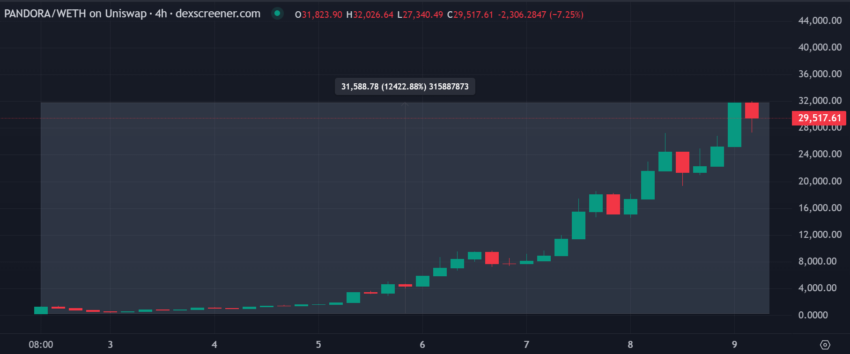This week, the first token conforming to the ERC-404 token standard is up 12,500%. The token blends the fungibility of ERC-20 tokens with the distinctive qualities of rare NFTs to herald a new era of tokenization.
Pandora’s PANDORA token has risen to $29,517.61 since its launch earlier this month.
Pandora Tokens Herald Era of Liquid NFTs
Pandora tokens are fractionally bound to a whole NFT. The tokens themselves are tradeable and liquid on decentralized exchanges (DEX) like a regular ERC-20 token. The fractions make the whole NFT as liquid as a regular DEX trading pair.
For example, Pandora’s 10,000 ERC-404 tokens are linked to 10,000 colored box NFTs with varying rarity levels. When someone buys an ERC-404 Pandora token, the project mints a random box bound to that token.
When someone sells the token, Pandora burns the related NFT. The NFTs themselves can be traded on NFT marketplaces.
Read more: ERC721- Non-Fungible Tokens Explained
Binance recently announced ERC-404 support in its Web3 wallet, while another marketplace, called Inscribe, also confirmed adoption. The rollout of marketplaces for ERC-721 alternatives like BRC-20, Bitcoin NFTs called Ordinals, and EVM inscriptions by crypto exchanges like Bybit and OKX may consider ERC-404 soon.
ERC-404’s Novel Approach to Fractionalization
The ERC-404 standard, developed by pseudonymous entities “ctrl” and “Acme,” is ‘EIP’ in name only. It is still experimental and hasn’t gone through the formal Ethereum Improvement Proposal vetting process. However, its key idea of building NFTs from fractions is the opposite of how NFT fractionalization works today.
The advent of real-world asset tokenization has spawned businesses specializing in creating liquidity by splitting RWA tokens. This process, they argue, gives rise to fractional models that welcome investors who cannot afford high-value assets.
ERC404, however, flips that process on its head. It builds whole ERC-721 tokens from smaller ERC-20 tokens.
Owners of the ERC-20 tokens can make money from providing liquidity on decentralized platforms. This is the opposite of many NFT projects today, whose goals are to mint high-value NFTs for big, one-time profits.
Read more: What is The Impact of Real World Asset (RWA) Tokenization?
The ERC-404 standard has attracted criticism. One developer named ‘quit’ said on X that lending pools may not be ready for the token. They said a protocol not configured to handle the standard may allow a user to withdraw the high-value NFT, not the fungible fractions.
“Our NFT depositor is marked as the owner of an NFT with token ID 38916. Our token depositor is marked as the owner of 1*10^18 ERC20 tokens…Let’s withdraw some of those tokens…Pandora interprets it as an ERC721 transfer, and thus our token depositor is able to steal the NFT from our NFT depositor,” quit said.
BeInCrypto has reached out to Pandora for comment but has yet to hear back.
![]()
PrimeXTB
PrimeXTB ” target=”_blank”>Explore →
![]()
Wirex App
Wirex App” target=”_blank”>Explore →
![]()
AlgosOne
AlgosOne” target=”_blank”>Explore →
![]()
YouHodler
YouHodler” target=”_blank”>Explore →
![]()
KuCoin
KuCoin” target=”_blank”>Explore →
![]()
Margex
Margex” target=”_blank”>Explore →
Explore more
The post This New Narrative on Ethereum Sees Its First Token Skyrocket 12,500% appeared first on BeInCrypto.
